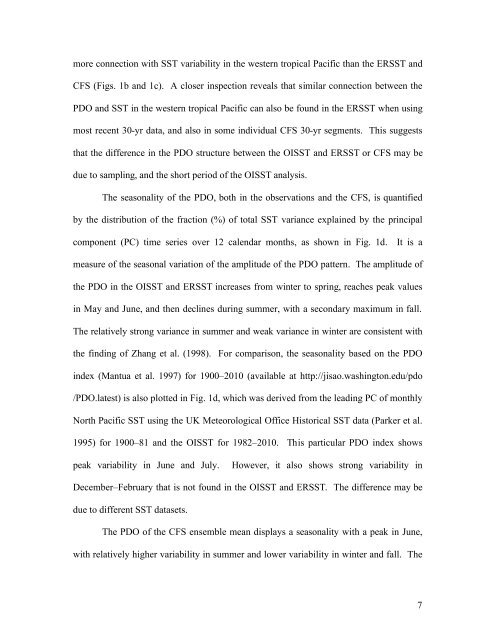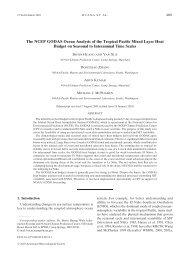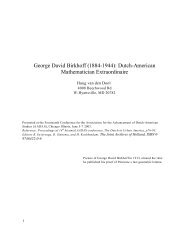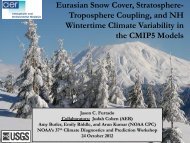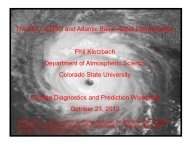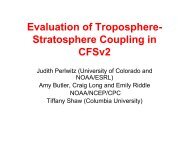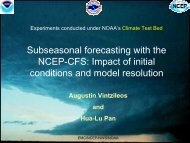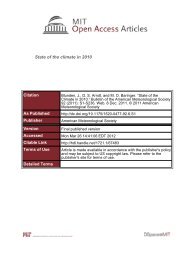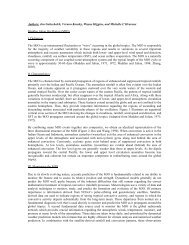Seasonality of the Pacific decadal oscillation - Climate Prediction ...
Seasonality of the Pacific decadal oscillation - Climate Prediction ...
Seasonality of the Pacific decadal oscillation - Climate Prediction ...
You also want an ePaper? Increase the reach of your titles
YUMPU automatically turns print PDFs into web optimized ePapers that Google loves.
more connection with SST variability in <strong>the</strong> western tropical <strong>Pacific</strong> than <strong>the</strong> ERSST and<br />
CFS (Figs. 1b and 1c). A closer inspection reveals that similar connection between <strong>the</strong><br />
PDO and SST in <strong>the</strong> western tropical <strong>Pacific</strong> can also be found in <strong>the</strong> ERSST when using<br />
most recent 30-yr data, and also in some individual CFS 30-yr segments. This suggests<br />
that <strong>the</strong> difference in <strong>the</strong> PDO structure between <strong>the</strong> OISST and ERSST or CFS may be<br />
due to sampling, and <strong>the</strong> short period <strong>of</strong> <strong>the</strong> OISST analysis.<br />
The seasonality <strong>of</strong> <strong>the</strong> PDO, both in <strong>the</strong> observations and <strong>the</strong> CFS, is quantified<br />
by <strong>the</strong> distribution <strong>of</strong> <strong>the</strong> fraction (%) <strong>of</strong> total SST variance explained by <strong>the</strong> principal<br />
component (PC) time series over 12 calendar months, as shown in Fig. 1d. It is a<br />
measure <strong>of</strong> <strong>the</strong> seasonal variation <strong>of</strong> <strong>the</strong> amplitude <strong>of</strong> <strong>the</strong> PDO pattern. The amplitude <strong>of</strong><br />
<strong>the</strong> PDO in <strong>the</strong> OISST and ERSST increases from winter to spring, reaches peak values<br />
in May and June, and <strong>the</strong>n declines during summer, with a secondary maximum in fall.<br />
The relatively strong variance in summer and weak variance in winter are consistent with<br />
<strong>the</strong> finding <strong>of</strong> Zhang et al. (1998). For comparison, <strong>the</strong> seasonality based on <strong>the</strong> PDO<br />
index (Mantua et al. 1997) for 1900–2010 (available at http://jisao.washington.edu/pdo<br />
/PDO.latest) is also plotted in Fig. 1d, which was derived from <strong>the</strong> leading PC <strong>of</strong> monthly<br />
North <strong>Pacific</strong> SST using <strong>the</strong> UK Meteorological Office Historical SST data (Parker et al.<br />
1995) for 1900–81 and <strong>the</strong> OISST for 1982–2010. This particular PDO index shows<br />
peak variability in June and July. However, it also shows strong variability in<br />
December–February that is not found in <strong>the</strong> OISST and ERSST. The difference may be<br />
due to different SST datasets.<br />
The PDO <strong>of</strong> <strong>the</strong> CFS ensemble mean displays a seasonality with a peak in June,<br />
with relatively higher variability in summer and lower variability in winter and fall. The<br />
7


